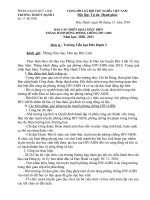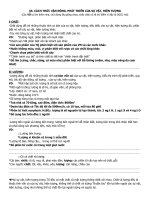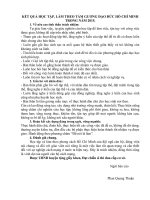Tuân Thủ Thuế – Nguyễn Hồng Thắng
Bạn đang xem bản rút gọn của tài liệu. Xem và tải ngay bản đầy đủ của tài liệu tại đây (240.16 KB, 34 trang )
TUÂN TH Ủ THU Ế
Nguyễn Hồng Thắng
Policymakers have two objectives in
designing a tax system...
Efficiency
Equity
Tiêu chuẩn một hệ thống thuế tốt
•
•
•
•
•
•
•
•
•
•
Transparency and Accountability
Equity and Fairness
Certainty
Convenience of Payment
Simplicity
Enhancing Economic Growth
Efficiency
Ability to pay (≠ willingness to pay)
pay
Appropriate Government Revenues
Neutrality
Transparency & accountability
Taxpayers should know that a tax exists and how
and when it is imposed upon them and others.
Enables taxpayers to know the true cost of transactions.
Enables taxpayers to know when tax is being assessed or
paid and to whom.
The principle can be explained as follows:
All of the tax law must be publish broadly.
Simplicity: easy to understand, implement and monitor.
State budget must be declared.
Transparency and accountability make a tax system
be practical.
Equity & Fairness
Similarly situated taxpayers should be taxed
similarly.
• Horizontal and vertical equity.
• “Fairness” (or really, the perception of
fairness).
• Should really look at entire range of taxes a
taxpayer is subject to.
Certainty
Tax rules should specify when the tax is to
be paid, how it is to be paid, and how the
amount to be paid is to be determined.
• Certainty, rather than ambiguity.
• Ability to determine tax base and rate.
• Basically, the level of confidence that exists that
the tax is being calculated correctly.
Convenience of Payment
A tax should be due at a time or in a
manner that is most likely to be convenient
for the taxpayer.
• Helps ensure compliance.
• Appropriate payment mechanism depends on
amount of liability and ease of collection.
Simplicity
The tax law should be simple so that
taxpayers can understand the rules and
comply with them correctly and in a costefficient manner.
• Reduces the amount of errors.
• Increases respect for the system.
• Enables taxpayers to understand tax
consequences of their transactions.
Economic Growth
The tax system should not impede or reduce
the productive capacity of the economy.
• Tax system should be aligned with the
economic goals of the jurisdiction imposing the
tax.
– For example, should be aligned with jurisdiction’s
economic goals for economic growth, capital formation
and int’l competitiveness.
– Should not favor one industry or type of investment at
the expense of others.
Taxes and Growth
/>Tax%20Cuts%20did%20not%20Create%20Celtic%20Tiger.pdf
Efficiency
• The costs to collect a tax should be kept to a minimum for
both the government and taxpayers.
– How many revenue officers are needed?
– Closely related to simplicity principle.
• Costs of implementation need reducing as low as possible
(the costs do not only include costs of tax collector but
also include social costs and opportunity costs)
– Tax should not change consumer and producer
behavior.
– Tax revenues increase with least distortion.
– Taxes must encourage private and foreign investment.
Efficiency
One tax system is more efficient than
another if it raises the same amount of
revenue at a smaller cost to taxpayers.
An efficient tax system is one that
imposes the smallest deadweight losses
and administrative burdens possible.
Benefits Principle
The benefits principle is the idea that people
should pay taxes based on the benefits they
receive from government services.
An example is a gasoline tax:
Tax revenues from a gasoline tax are used to
finance our highway system.
People who drive the most also pay the most
toward maintaining roads.
Ability to Pay
•
•
•
•
Tax burden accords to ability to pay
Tax burden should be distributed fairly
Tax burden should be made progressive
Tax revenue has to finance government
expenditure adequately
• Tax revenue depends on:
–
–
–
–
Tax rate
Tax base
Elasticity of demand and supply
Capacity to administer
Ability-to-Pay Principle
The ability-to-pay principle is the idea
that taxes should be levied on a person
according to how well that person can
shoulder the burden.
The ability-to-pay principle leads to two
corollary notions of equity.
Vertical equity
Horizontal equity
Vertical Equity
Vertical equity is the idea that
taxpayers with a greater ability to pay
taxes should pay larger amounts.
For example, people with higher incomes
should pay more than people with lower
incomes.
Vertical Equity and Alternative Tax
Systems
A proportional tax is one for which highincome and low-income taxpayers pay the
same fraction of income.
A regressive tax is one for which highincome taxpayers pay a smaller fraction of
their income than do low-income taxpayers.
A progressive tax is one for which highincome taxpayers pay a larger fraction of
their income than do low-income taxpayers.
Three Tax Systems
Proportional Tax
Income
Amount
of Tax
Percent
of Income
Regressive Tax
Amount
of Tax
Percent
of Income
Progressive Tax
Amount
of Tax
Percent
of Income
$50,000
$12,500
25%
$15,000
30%
$10,000
20%
100,000
25,000
25%
25,000
25%
25,000
25%
200,000
50,000
25%
40,000
20%
60,000
30%
The Burden of Federal Taxes
Quintile
Lowest
Second
Middle
Fourth
Highest
Average
Income
$ 9,880
26,100
44,300
68,200
174,000
Taxes as a
Percent of
Income
Percent
of All
Income
8.0%
15.6
20.3
23.1
29.1
4%
11
16
20
49
Percent of
All Taxes
1%
7
13
19
59
Horizontal Equity
Horizontal equity is the idea that
taxpayers with similar abilities to pay
taxes should pay the same amounts.
For example, two families with the same
number of dependents and the same
income living in different parts of the
country should pay the same federal taxes.
Appropriate Government
Revenues
• The tax system should enable the government to determine
how much tax revenue will likely be collected and when.
– Need to have some level of predictability and reliability to
enable governments to know how much will be collected and
when.
– Generally, government realizes better stability with a mix of
taxes.
• Necessary to maintain continuity of fiscal policies
• A stable system of tax is one that ensures government a
certain source of operating revenues and provides taxpayers
with some degree of certainty concerning the amount of their
annual tax liability.
• Tax system must cover all tax base (actual and potential
base)
• Government needs to build up an elastic tax system.
Neutrality
• System of tax should not change investment
decisions in a way that bad projects get
preference over good projects.
• The effect of the tax law on a taxpayer’s
decisions as to how to carry out a particular
transaction or whether to engage in a
transaction should be kept to a minimum.
– Taxpayers should not be unduly encouraged or
discouraged from engaging in certain activities due
to tax law.
– Primary purpose of tax system is to raise revenue,
not change behavior.
Những câu hỏi
• Có hệ thống thuế tại quốc gia nào thỏa
mãn tất cả những yêu cầu vừa nêu?
• Những nguyên tắc nào mâu thuẫn
nhau?
• Một bộ (a set of) nguyên tắc nào phù
hợp cho Việt Nam trong giai đoạn hiện
tại và cho đến năm 2010?
Cải cách thuế tại Việt Nam
Cải cách thuế
• Quá trình sắp xếp nội dung các khoản thuế, cơ
cấu hệ thống thuế và bộ máy quản lý thu thuế.
• Lý do: Hệ thống thuế VN vẫn chưa tương thích
những thông lệ chung về thuế của cộng đồng
thế giới. Thậm chí khi đã tương thích rồi cũng
vẫn tiến hành cải cách thuế nếu thực tiễn kinh tế
đã diễn ra những thay đổi căn bản.
• Cải cách thuế là một việc làm thường xuyên của
nhà nước và gắn liền với đời sống kinh tế - xã
hội của một đất nước.
• Một trong các quyền và nghĩa vụ của công dân là
phải biết về thuế và những thay đổi trong chính
sách thuế.









